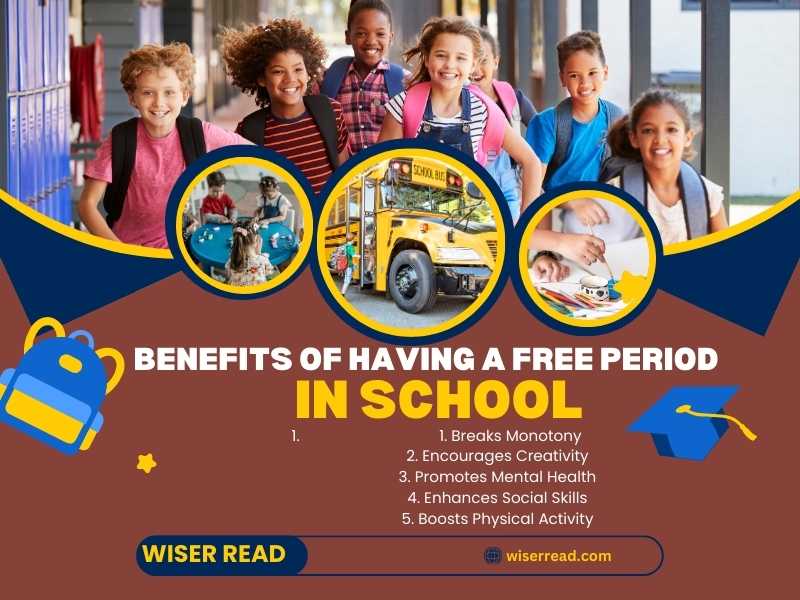Free periods in school offer students a break from the rigorous academic schedule. They foster creativity, rest, and personal development. You will get here the 10 Benefits of Having a Free Period in School with 10 Pros of being a high school teacher. A free period in school is more than just a break from lessons. It’s an opportunity for students to recharge, explore their interests, and enhance their well-being.
By offering a balance between academics and personal time, free periods help foster creativity, social connections, and mental health, all while boosting productivity and time management skills. Embracing this time not only benefits students’ academic performance but also nurtures their overall growth, preparing them for both the classroom and life beyond school.
10 Benefits of Having a Free Period in School
- Breaks Monotony: Shifts focus, reducing academic fatigue.
- Encourages Creativity: Time for arts, music, or writing.
- Promotes Mental Health: Reduces stress, and improves well-being.
- Enhances Social Skills: Opportunities for interaction outside class.
- Boosts Physical Activity: Encourages movement or sports.
- Facilitates Self-Learning: Space for personal research or reading.
- Improves Time Management: Students learn to use time wisely.
- Supports Clubs and Activities: Time for extracurricular involvement.
- Reduces Burnout: Prevents academic and emotional exhaustion.
- Increases Productivity: Refreshed minds work better.
Explain the Benefits of Having a Free Period in School
Breaks Monotony
Having a free period in school provides a welcome break from the rigorous and repetitive academic schedule. It shifts the focus from constant learning, allowing students to recharge mentally. This reduction in academic fatigue enhances focus and productivity in subsequent lessons, making the overall school day feel more balanced and less overwhelming.
Encourages Creativity
A free period offers students the time and space to engage in creative activities such as arts, music, or writing. With fewer academic pressures, students can explore their imaginations, develop new hobbies, and express themselves in ways that might not fit into the structured classroom environment, fostering innovation and self-expression.
Promotes Mental Health
A free period allows students to take a mental break, reducing stress and anxiety caused by continuous studying or academic pressure. It provides an opportunity to relax, meditate, or engage in calming activities, contributing to better mental well-being and emotional resilience, making students feel more balanced and less overwhelmed.
Enhances Social Skills
Time outside of class during a free period enables students to interact with peers in a less structured environment. They can build and strengthen friendships, practice communication skills, and learn how to collaborate and negotiate in informal settings, all of which are crucial for personal development and social growth.
Boosts Physical Activity
Free periods can encourage students to move around, play sports, or engage in outdoor activities. Physical movement during breaks is essential for maintaining physical health, as it helps release energy, improve focus, and prevent the sedentary behavior that often accompanies long hours of studying.
Facilitates Self-Learning
During a free period, students can use the time for personal exploration. They can read books, conduct research on topics of interest, or work on assignments at their own pace. This self-directed learning nurtures curiosity, helps develop independent study habits, and promotes lifelong learning beyond the curriculum.
Improves Time Management
When students are given a free period, they learn how to prioritize and manage their time effectively. Whether they decide to study, socialize, or relax, they are making choices about how to use the time, which helps them develop time-management skills that are useful not only in school but also in future careers and personal life.
Supports Clubs and Activities
Free periods give students the flexibility to participate in extracurricular activities or school clubs that might be held during school hours. Whether it’s a debate team, music group, or volunteer project, students can explore their interests and talents, enriching their overall school experience beyond academics.
Reduces Burnout
Continuous academic pressure can lead to burnout, where students feel exhausted and disengaged from learning. Free periods act as a buffer, offering students a chance to step away from their studies and reset. This break helps to prevent emotional and academic exhaustion, keeping students motivated and engaged in the long term.
Increases Productivity
After a free period, students are likely to feel refreshed and more focused, which can lead to improved performance in their academic tasks. A break helps clear the mind and rejuvenate energy levels, resulting in more effective learning, quicker problem-solving, and a sharper ability to retain information when they return to their classes.
Top 10 Pros And Cons of Being a High School Teacher
You will get here the 10 Pros and cons of Being a High School Teacher. Now, let’s see the pros and cons of being a high school teacher.
10 Pros of being a high school teacher
1. Impactful Role: Ability to shape young minds and influence future generations.
2. Job Security: High demand for educators ensures stable employment.
3. Summer Breaks: Enjoy long vacations, including summer, winter, and spring breaks.
4. Variety: Teaching different subjects or grades keeps the job dynamic.
5. Intellectual Stimulation: Constant learning to keep up with curriculum changes.
6. Community Connection: Strong ties with the local community and parents.
7. Creative Freedom: Opportunity to innovate in teaching methods and materials.
8. Health Benefits: Often includes good health insurance and pension plans.
9. Work-Life Balance: Regular hours, though preparation might extend beyond school time.
10. Personal Growth: Continuous professional development opportunities.
10 Cons of Being a High School Teacher
1. High Stress: Dealing with student behavior, workload, and administrative pressures.
2. Limited Pay: Often, salaries do not match the level of education and responsibility.
3. Bureaucracy: Excessive paperwork and adherence to policies can be stifling.
4. Parental Pressure: Managing expectations and sometimes unreasonable demands from parents.
5. Classroom Management: Challenges with discipline, especially in larger classes.
6. Resource Constraints: Lack of funding can impact teaching resources and the environment.
7. Standardized Testing: Teaching to the test can limit educational creativity.
8. Emotional Labor: Navigating students’ issues adds an emotional burden.
9. Professional Isolation: Teachers might feel disconnected from colleagues due to individual classroom settings.
10. Time Commitment: Evenings and weekends are often spent on grading or lesson planning.
Being a high school teacher offers a blend of rewarding experiences with significant challenges, requiring a balance of passion, patience, and resilience.
Do You Get Free Periods in High School?
Yes, you can get free periods in high school but with caveats. Some high schools incorporate free periods, often called “study halls” or “open blocks,” into their daily schedules. These periods are designed to give students a break from structured class time, allowing them to:
- Work on homework or projects.
- Study for upcoming exams.
- Participate in clubs or extracurricular activities.
- Have one-on-one time with teachers for extra help.
- Simply relax or socialize, providing a mental break.
Not all high schools offer this luxury. Schools with packed schedules, especially those in urban areas or with limited staffing, might not provide unscheduled time. Instead, students might have:
- A very tight schedule with no gaps between classes.
- Mandatory study sessions or additional classes for remediation or enrichment.
- Lunch periods as the only unstructured time, which isn’t always conducive to deep study or relaxation.
The nature of free periods can differ:
- Scheduled Free Periods: Some schools have this as a consistent part of the daily or weekly timetable.
- Optional Free Periods: Students might opt into free periods instead of electives or additional courses.
- Earned Free Periods: In some systems, students might earn free periods based on academic performance or behavior.
The presence of free periods also reflects educational policy shifts towards student well-being, recognizing the importance of downtime for mental health and effective learning. Yet, it’s contingent on school resources, administrative philosophies, and the broader educational climate of the area
FAQ’s on Benefits of Having a Free Period in School
What is a free period?
An unscheduled time for students to use at their discretion.
How often should schools have free periods?
Daily or weekly, based on school schedules and student needs.
Can students misuse free periods?
Yes, but proper guidance can mitigate this.
Do free periods affect academic performance?
They can enhance performance by providing necessary breaks.
Are teachers involved during free periods?
Typically, they’re available for guidance but not direct teaching.
Last Word
Incorporating free periods in school schedules is crucial for a holistic education. They offer students the chance to grow beyond academics, ensuring a balanced development.

